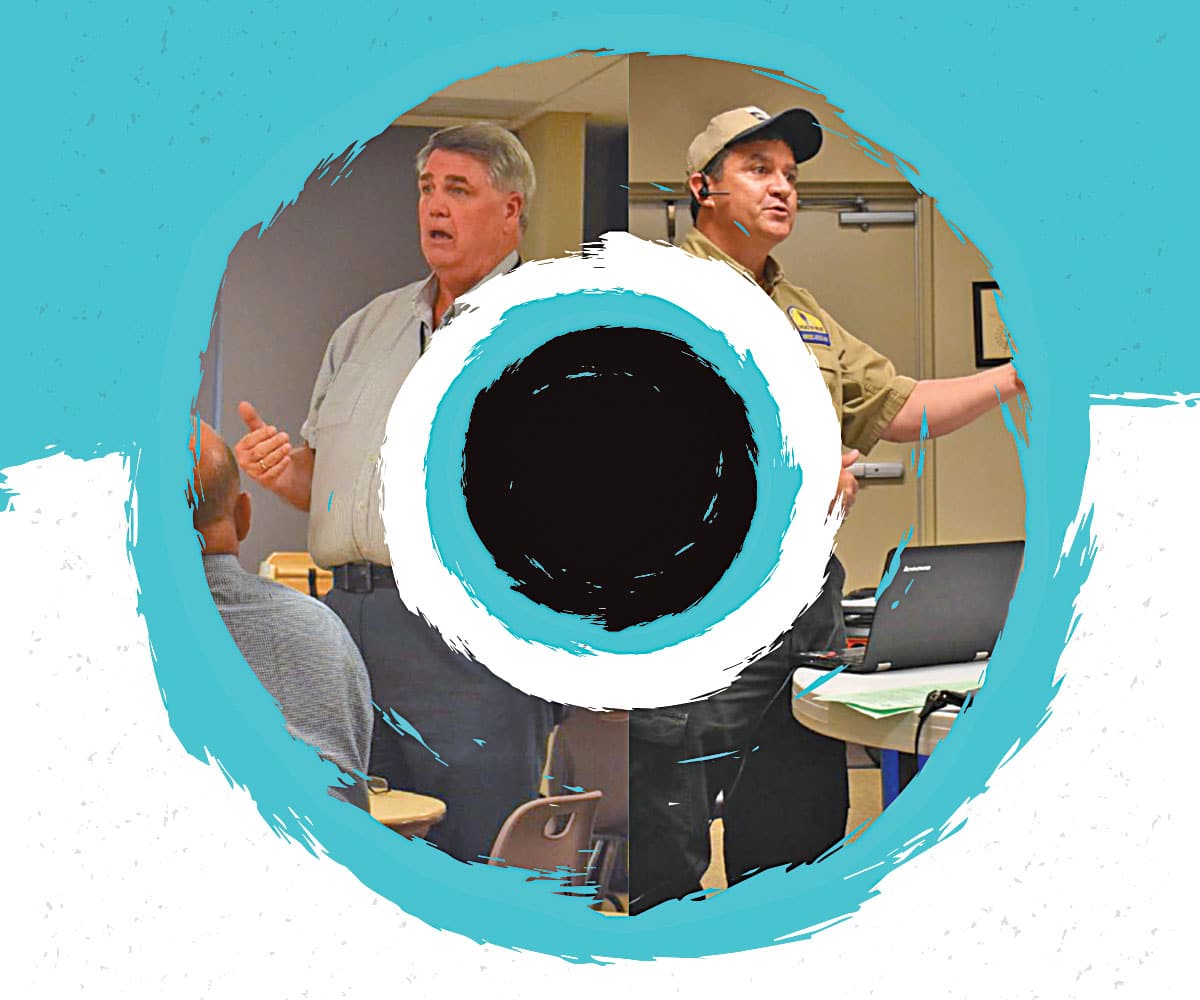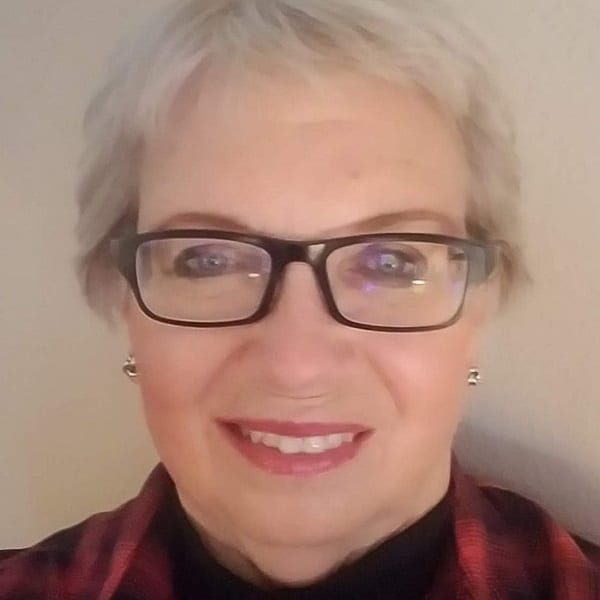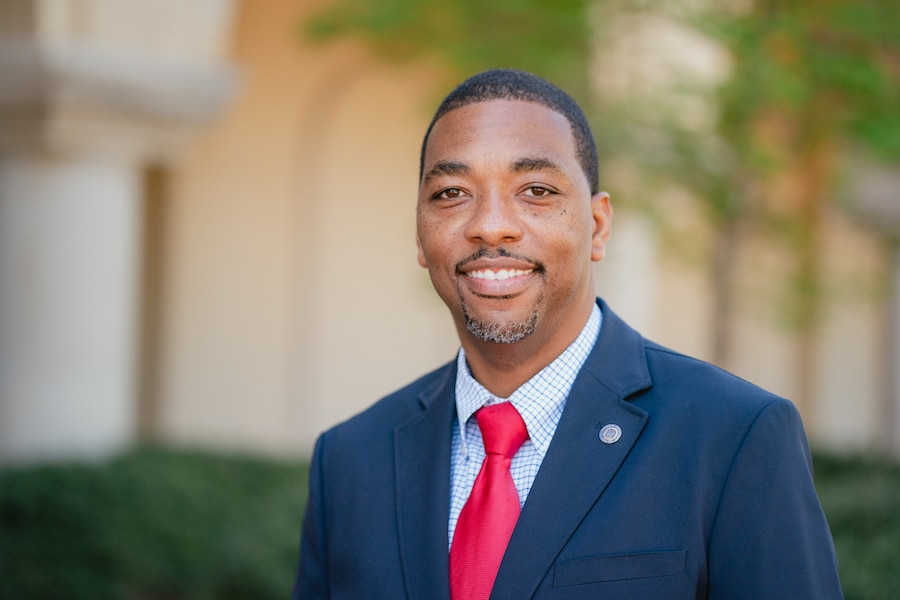Ministering in a hurricane zone is an exhausting – but rewarding – calling
As hurricane season nears each year, many pastors—especially those in the storm-prone Golden Triangle of Texas—watch weather reports with a mix of angst and awe: will their churches and communities be spared, or will the next hurricane deliver yet another gut punch from the Gulf of Mexico, leaving their congregations and neighborhoods reeling?
It takes a special person to be a disaster pastor.
Theological training isn’t enough. One must know how to mobilize volunteers, marshal resources … and sometimes man a chainsaw, mud out a flooded home or operate a ham radio.
Daniel White of First Baptist Church Kountze and Terry Wright of First Baptist Church Vidor are just two of hundreds of Southeast Texas pastors who know firsthand about the human and spiritual challenges of living—and ministering—in a hurricane zone.
A DR whirlwind
The 2021 Atlantic hurricane season is just about over—it begins June 1 and lasts through the end of November. Its arrival each year sets into motion a train of thinking and a posture of preparation for pastors that can leave their minds swirling.
“Your mind just starts going through what you need to do,” White said. “What preparations do we need to make? Who is evacuating from among the congregation? Whose home will need to be checked on? Which church members have generators?”
It can be overwhelming, said White, a long-time Southern Baptists of Texas Disaster Relief volunteer who also became a part-time SBTC DR associate in 2015.
Involvement in disaster relief has characterized White’s pastoral career for the last 15 years. While pastoring First Baptist Eagle Pass in 2006, he was recruited by Scottie Stice, then director of missions of the Del Rio-Uvalde Baptist Association, to use his ham radio skills to run communications for SBTC DR.
White quickly trained to become a credentialed SBTC DR volunteer.
“There are other groups out there doing DR, but very few can minister in the way that we do,” White said. “Very few are sharing the gospel.”
He got a chance to employ his DR skills sooner than expected when a tornado hit Eagle Pass within a month of his training. Immediately, he phoned Stice and then SBTC DR Director Jim Richardson, both attending the National SBDR Roundtable in Alabama. Stice and Richardson hopped a plane back to Texas to arrange for help for Eagle Pass and Mexico, also hit hard by the twister.
“It’s been a whirlwind ever since,” White said.
First Baptist Eagle Pass opened its doors to hundreds of SBDR volunteers following the tornado: mass feeding crews and recovery teams, all of whom ministered on both sides of the Rio Grande.
“There were cots and sleeping bags everywhere. One volunteer even slept in the baptistry,” White recalled.
“Daniel’s churches always serve as ministry centers for us,” Stice, SBTC DR director, said. “They open their doors whenever we need a staging area or facilities.”
First Baptist Kountze: above the storm
Tornadoes may be rare in Eagle Pass, but hurricanes and floods are common in Southeast Texas, as White found out soon after assuming the pulpit at First Baptist Kountze in November 2015. A major storm system dumped record rainfall, causing flooding in Lumberton and Deweyville. FBC Kountze, located 25 miles north of Beaumont, opened its doors as a staging ground for relief efforts.
Then came Harvey in 2016, which pummeled Aransas Pass and the Gulf Coast with damaging winds and days of torrential rain which stalled over Houston before moving to the Golden Triangle.
Although out of Harvey’s path, FBC Kountze became, at the county’s request, “a shelter of last resort,” a respite stop for evacuees awaiting transport to larger shelters.
They came. And they stayed, as many as 60-70 at the height of the crisis.
So what does a small church do when faced with such a daunting task?
Said White: “The best we could.”
They wrangled cots and accepted donated food from grocery stores and restaurants. Volunteers from the church and other congregations came to cook. “We made it happen,” White said. The fact that FBC Kountze had established SBTC DR teams in place helped.
When most evacuees cleared out after a week, White and the congregation still fixed meals for those remaining and for first responders.
“When disaster happens, the community can rely on us. Our involvement gives us a good image in the community. We have a witness and a testimony. Sometimes people get involved in our church who might not otherwise.”
Daniel White of First Baptist Church Kountze Tweet
“When disaster happens, the community can rely on us,” White said. “Our involvement gives us a good image in the community. We have a witness and a testimony. Sometimes people get involved in our church who might not otherwise.”
First Baptist Vidor: a tale of four storms and a pandemic
A mixture of involvement with SBTC DR and Texas Relief/Rebuild is a hallmark of Pastor Terry Wright’s DR ministry at First Baptist Vidor. With four hurricanes in 14 years directly impacting his church, Wright understands the challenges of living through
disaster.
“Rita, Ike, Harvey, Imelda—four major hurricanes and seven smaller storms that caused some kind of response,” Wright said, summarizing the weather events affecting the church from 2005-2019.
Wright said Harvey was the worst by far. The Category 4 storm stretched resources thin across the region and damaged half the church’s property.
The buildings at FBC Vidor that did not flood were used to shelter families who had lost their homes and relief groups who came to help.
Then Imelda struck in 2019 with a vengeance.
“Everything we owned was flooded during Imelda except for the office building,” Wright said. Suddenly there was “no place to go” for services.
A recent merger with the former Northwest Baptist Church on the north side of Interstate 10 eased the situation as FBC Vidor focused efforts on repurposing that property while dealing with insurance and other issues in rebuilding the main campus.
FBC Vidor moved into the old Northwest Baptist Church property. Then the pandemic hit, complicating things because the facilities were not large enough to allow for COVID protocols and social distancing.
“Imelda made the pandemic very, very hard on the church,” Wright admitted.
Yet these days the waters are smoother.
“We are back into our regular facilities,” Wright said, noting that both sanctuary and educational spaces damaged during Harvey and Imelda have been remodeled.
The process has been lengthy, involving insurance challenges resulting from the settlements of multiple claims, but the church emerged without having to take on additional debt, Wright noted with gratitude.
Disasters demand a plan
In the Golden Triangle region, the only things certain are death, taxes and storms.
When a hurricane is brewing in the Gulf, Wright said “an immediate apprehension” sets in. He and his staff adopt a mindset of preparedness.
“You not only have your own property to prepare [for a storm], but you have to prepare for insurance issues. Do you have the right documents?” Wright said. “You have to prepare your people, too. There will always be folks who do not have a place to go. The church helps them in evacuation.”
“You not only have your own property to prepare [for a storm], ... You have to prepare your people, too. There will always be folks who do not have a place to go. The church helps them in evacuation.”
Terry Wright of First Baptist Church Vidor Tweet
Wright called the safety of his people the “first priority,” adding that every story is different. “Some you cannot really prepare for. You have to wait and see what happens and come back and deal with it.”
The staff has a procedure it executes when a hurricane warning or watch is announced. Church members are notified electronically of the threat. Staff members identify people’s needs. Others secure the buildings and property. They prepare for the aftermath, ensuring there is fuel on site and that the church’s generators are operational. The church’s “rolling stock”—trailers, vans, buses—must often be relocated to higher ground. Deacons and members help the staff with the process.
The preparation alone can exhaust a church days before a storm actually hits.
Rita’s evacuation was the largest in U.S. history, Wright said, occurring when the trauma of Katrina was still fresh. Houston was evacuated first and many headed eastward to the Golden Triangle. Then the storm changed course and came there.
Evacuation was a surreal event, Wright said, proving for many to be just as stressful as what they would encounter in terms of damage after the storm.
Harvey brought more than its share of flooding. “There was water in Orange County deeper than anyone living had ever seen,” Wright said. “Senior adults lost all the mementos of their lives. If you didn’t flood, your house became a dormitory for people whose houses had flooded.”
Month after month of people helping people took a toll, he added. The stresses on church staff, leadership, and members were constant.
“You have to be careful that it doesn’t take a toll on your relationships,” said Wright, who has pastored his home church for nearly three decades. “Heavy stress brings out the best and worst in people. It affects the family. It affects the church family.”
With crisis comes opportunity
Even so, there is a refining process that can happen for the churches that trust the Lord to work all things together for good in the midst of challenging seasons.
“Hurricane Rita changed our church for the better,” Wright said. “We saw spiritual maturity. We learned what really mattered and what didn’t. People and the Lord are what matter.”
“Hurricane Rita changed our church for the better. We saw spiritual maturity. We learned what really mattered and what didn’t. People and the Lord are what matter.”
Terry Wright Tweet
His congregation experienced blessings in the crisis: enriched fellowship, renewed commitment, the chance to show younger generations the benefit of denominational cooperation. Wright also said he personally received the blessing of getting phone calls and texts from people across the nation who have previously assisted his church after a storm—including from SBTC executive director Jim Richards (who has since retired) and chief financial officer Joe Davis.
Like White, Wright affirmed that disasters also provide gospel opportunities. Recalling the old gospel song, “The Lighthouse,” which depicts Christ as a lighthouse in times of storm, Wright said the Lord also expects the church to “be a lighthouse.”
“In your community, people who have been hard-hearted toward the gospel—their hearts are softened,” he said. “When you minister in a tangible way, when a mud out unit pulls up and they stop and build a relationship, preconceived notions about the church vanish. Hearts melt.”
Though the physical and mental toll have been heavy, Wright admits that his story and the stories of other “disaster pastors” is one that mimics the biblical account of Jonah—who was “stretched beyond his comfortable comfort zone.”
“If you had told me 35 years ago—I was a church planter—that this is going to be what you do, [be] a disaster pastor, I wouldn’t have gotten in line,” Wright said. “Who wants to be in that group?”
Only those who are called to it.














